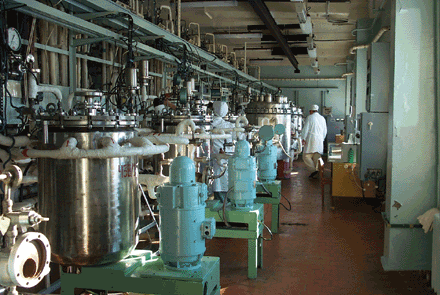U.S. Funds Ukrainian Former Bioweapons Facility Handling ‘Dangerous Materials… With Windows Wide Open’.


The lab’s scientists said they work without Western-style safety equipment.
A Ukrainian biolab receiving funds from the U.S. government was formerly a bioweapons factory under the control of the Soviet Union, with experts recently reporting a “lack of modern biosafety equipment” as well as “lethal microbes that in the West would be locked away in high-containment laboratories,” the National Pulse can reveal.
An article published by the Washington Post on August 30th, 2005 – “U.S. to Aid Ukraine in Countering Bioweapons” – reveals a lab now receiving U.S. government funds formerly “supplied highly lethal pathogens to Soviet bioweapons factories”:
“One lab to receive funding is the I.I. Mechnikov Antiplague Scientific and Research Institute, in the Black Sea port city of Odessa. The institute was part of a Cold War network of “antiplague” stations that supplied highly lethal pathogens to Soviet bioweapons factories.”
In 2008, researchers from the James Martin Center for Non-Proliferation Studies in Monterey California noted of the the Mechnikov facility:
“…its management claimed in 2003 that it knew nothing about either the Soviet offensive or defensive [bioweapons] program. We question the second since it was in effect a closed facility until the late 1980s and worked on highly dangerous Group II pathogens and, probably, at least at time on some Group I pathogens since at least 1965. It would make sense if at least one of its laboratories worked on Problem 5 projects.
“Problem 5” was the codename given to the Soviet bioweapons program.
Another report by the James Martin Center revealed disturbing practices at the U.S.-funded facility (emphases added):
The lack of modern biosafety equipment is also raising concern among U.S. officials about the potential for an accidental release of deadly bacteria and viruses. In Odessa, where 44 scientists and about 140 support staff carry out research in the I.I. Mechnikov Anti-plague Scientific and Research Institute, scientists wearing cotton smocks and surgical masks work with lethal microbes that in the West would be locked away in high-containment laboratories and handled only by scientists in spacesuits. The lab’s scientists said their training in handling dangerous materials allowed them to work safely with pathogens without Western-style safety equipment—which they viewed as unnecessary and which in any case they cannot afford. “Many of the institutes are located in downtown areas, and some work with pathogens with windows wide open,” said Sonia Ben Ouagrham, who coauthored the Monterey study with Zilinskas and Alexander Melikishvili.
The news follows Biden State Department official Victoria Nuland telling the U.S. Senate that the American government is concerned about biological research facilities falling into Russian hands as a result of the ongoing conflict in Eastern Europe, despite the department appearing to correct her testimony the following day.
The unearthed article also confirms a previous National Pulse report revealing how former President Barack Obama spearheaded negotiations leading to the lab eventually receiving U.S. government funds as part of a memorandum of understanding with the U.S. Department of Defense.
“The agreement, the result of more than a year of negotiations, was announced by Sens. Richard G. Lugar (R-Ind.) and Barack Obama (D-Ill.) during a visit to the Ukrainian capital, Kiev,” notes The Washington Post.
A separate article from The Irish Times – “Odessa Labs Host Deadly Legacy” – explains the Odessa-based laboratory’s former connections to the Soviet Union’s biological weapons programs.
Dubbed a “repository of knowledge, equipment and lethal pathogens that could be useful to bioterrorists,” the lab Obama negotiated to receive U.S. funds was highlighted for its inadequate safety precautions.
“The institutes were not officially part of the Soviet bioweapons complex, so they have been ineligible for the tens of millions of dollars given each year by western governments to keep former weapons scientists from selling their expertise. These governments are just beginning to look for ways to help the institutes, and not only because of the bioterrorism threat. In a two-year study of Russia’s biotech industry, a panel of the US National Academy of Sciences recently urged former Soviet republics to modernize the anti-plague labs and integrate them with other global networks working to prevent pandemics,” added the article.
“They often have culture collections of pathogens that lack biosecurity, and they employ people who are well-versed in investigating and handling deadly pathogens,” said Raymond Zilinskas, a bioweapons expert and co-author of a draft report by scholars from the Centre for Nonproliferation Studies at the Monterey Institute of International Studies on the role of Ukrainian labs in Soviet bioweapon efforts
“Some are located at sites accessible to terrorist groups and criminal groups,” he added.
The unearthed bio lab facility follows intense scrutiny over the U.S. government’s decision to fund risky, “gain-of-function” research in Wuhan at a Chinese Communist Party–run lab with military ties.
Source: National Pulse | Image: Science Publication. Image is not of the said lab(s) in Ukraine.
DISCLAIMER: The author is solely responsible for the views expressed in this article. The author carries the responsibility for citing and/or licensing of images utilized within the text.
